THE TVR VIXEN S1 – A CELEBRATION
20 January 2023
A long time ago, in the year when Brotherhood of Man won the Eurovision Song Contest, I encountered a fascinating two-seater coupe in the village garage. Most of the time, the front yard seemed to contain a familiar array of decaying Singer Vogues and Vauxhall Viva HAs, so this was an entirely different form of car. For one, it looked almost brutish, and secondly, it sported ‘Ban The Bomb’ tail lights from the Ford Cortina Mk. I. Even now, I can recall how my six-year-old self was decidedly impressed by that TVR Vixen as it seemed poised to dart along the A27.
And when the first-generation Vixen debuted in October 1967, it marked a sea change for its manufacturer. Two years earlier, Arthur and Martin Lilley had acquired TVR, and the latest model was rather more than a modified version of the outgoing Grantura 1800S Mk. 4. The two cars may have shared the same chassis, but the Vixen was the marque’s first vehicle with a Ford engine. TVR had previously experienced supply problems with the British Motor Corporation, so they opted for the Cortina GT Mk. II’s 1,599cc unit with a cross-flow cylinder head. The company also offered the ‘Vixen 1800’ but made only 12 examples as they wanted to use their MGB 1.8-litre engine stocks.

The latest TVR was decidedly compact at four feet in height and 11 feet 6 inches long, and the cost was £998 in kit form or £1,216 as a fully-built car. Such figures were not particularly extravagant in 1967; the brochure stated the Vixen “offers high performance motoring at family car price”. The options list included two-speed wipers, a laminated windscreen, hazard warning lights, a leather-covered steering wheel and servo-assisted brakes. Luggage space access was via tipping the front seats.
Meanwhile, your TVR dealer would gladly tell you that the top speed was 109 mph with 0-60 in 11 seconds. Autocar praised the “beautifully balanced handling” and thought “a standing-quarter mile in 18.1sec makes very enjoyable motoring, which points to the conclusion that the Vixen is mainly intended for the man who simply enjoys driving quickly”. John Bolster of Autosport seemed even more impressed, describing it as “very much a sports car, but it also provides practical everyday transport and there is even of luxury about it”.
When the S2 replaced the S1 in October 1968, 117 examples had left the factory, compared with 78 units of its predecessor. The Vixen 1600 marked a new direction for TVR, combining Ford engines with that distinctive bodywork. Perhaps my younger self really did possess good taste in motor cars…
